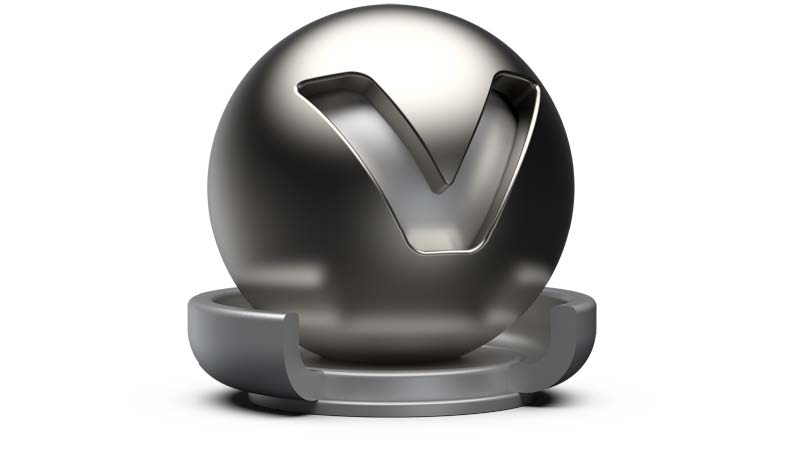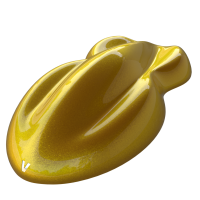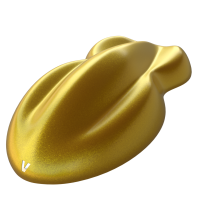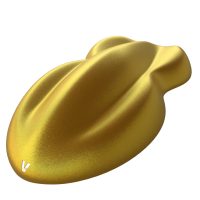Brushed Metal
![]()

The brushed metal material type simulates any type of metal; it gives full control over the scale and orientation of the surface structure. Metal type presets are available within the Properties Editor.
For this material, there is no choice between UV and Planar Mapping. The texture mapping is as follows:
- For Diffuse, Glossy, Bump, and Roughness, it depends on the brush mapping orientation.
- UV-mapping is used for radial and planar brush mapping.
- Triplanar mapping is used for triplanar brush mapping orientation.
- UV-mapping is always used for Incandescence, Transparency, and Displacement textures.
Brushed Metal Material
Diffuse Color - Sets the diffuse reflection color of the material.Use the slider to change the brightness. Click the color field on the right to open the color chooser. Assigning a texture to the diffuse color projects it onto the surface. The appearance is a combination of the defined color and the assigned texture.
Glossy Color - Sets the glossy reflection color of the material. The higher the brightness, the higher the reflection on the surface. Black means no reflection; white gives full reflection. Click the color field on the right to open the color chooser; when the chrome reflection is colored, reflected objects are also colored. Assigning a texture to the glossy channel defines areas in which different gloss intensities appear with the help of a texture. The glossy color depends finally on both the defined color and the assigned texture file.
Roughness UV - Controls the sharpness of the glossy reflections. The higher the value the rougher the microscopic structure on top of the surface and the more blurred are the reflections. Different values for horizontal and vertical roughness provide every type of refraction behavior that is commonly known from metallic surfaces.
Metal Type - Sets the metal type to use to define the characteristics of the metal. These metal types are available: Custom Reflectivity, Aluminum, Amorphous Carbon, Silver, Gold, Cobalt, Copper, Chromium, Lithium, Mercury, Nickel, Potassium, Platinum, Iridium, Silicon, Amorphous Silicon, Sodium, Rhodium, Tungsten, Vanadium, and Iron.
Reflectivity - Sets the brushed metal’s reflective intensity. The higher the value, the more reflective.
Clearcoat
Sets the clearcoat color. The clear coat is a transparent, reflective paint layer on the base metal layer.
Type - Defines the intensity of a reflection, based on the viewing angle. Its intensity at normal incidence is set by the material's reflectivity. Choose from the following:
Color - Sets the pigment color of the clearcoat, which slightly darkens the overall color of the brushed metal.
Refraction Index - Sets the material's refraction index. The index of refraction allows glass-on-glass contact situations. It shows the amount the rays are reflected off the surface versus absorbed (refracted into the surface).
Roughness - Imitates clearcoat spray paint high-gloss satin and matte finishes. Now, you can control the roughness, thickness, and density of the clearcoat for most materials, such as Plastic, Brushed Metal, Metallic Carpaint, and Carbon (2D/3D).
Roughness of 0 Roughness of 0.1 Roughness of 1.0 


Thickness - Sets the thickness of the clearcoat.
Density - Determines the concentration of particles in the clearcoat, which affects the color of the clearcoat. Use this in combination with Thickness and a non-white color, as white is completely transparent.
Use Orange Peel - Applies a bump structure to the layer. Use the following options to customize this:
Orange Peel Frequency - Sets the bump structure's noise frequency. The higher the value, the closer together the orange peel bumps.
Orange Peel Intensity - Sets the bump structure's intensity. The higher the value, the more visible the orange peel and less smooth the clearcoat surface.
Brush Orientation
Brush Mapping - Allows you to choose between a range of possible brush orientations, for example, metal brushed in one direction or metal with radial brushes. For example, Brush Mapping Radial XY simulates radial brushes within the XY-plane. The projection planes are defined relative to the object coordinate system of the object the material is assigned to.
Size U/V - Defines the brush’s size on the U/V-axis.
Center X/Y/Z - Only available for Radial brush mappings. Sets the projection plane’s center of the radial brushes.
Get Center - Only available for Radial brush mappings. Returns the Center X, Y, and Z transformations to Zero.
Orientation X/Y/Z - Only available for Radial or Planar brush mappings. Sets the projection plane's orientation.
Rotate X/Y/Z - Only available for Triplanar brush mapping. Sets the projection plane’s rotation on the X/Y/Z-axis.
Roughness Texture
For Brushed Metal, red and green color channels are used for U and V roughness. The roughness parameter controls light refractions on top of the surface. The higher the value, the rougher the microscopic structure on top of the surface and the more blurred are the reflections.
- Minimum Roughness U - Defines the horizontal roughness value to which a texture value of 0 is mapped. The higher the value, the rougher the microscopic structure on top of the surface and more blurred the reflections. Sets the minimum value for the horizontal roughness for every type of refraction behavior commonly known from metallic surfaces, using the red color channel of the roughness texture.
- Maximum Roughness U - Defines the horizontal roughness value to which a texture value of 1 is mapped. The higher the value, the rougher the microscopic structure on top of the surface and more blurred the reflections. Sets the maximum value for the horizontal roughness for every type of refraction behavior commonly known from metallic surfaces, using the red color channel of the roughness texture.
- Minimum Roughness V - Defines the horizontal roughness value to which a texture value of 0 is mapped. The higher the value, the rougher the microscopic structure on top of the surface and more blurred the reflections. Sets the minimum value for the vertical roughness for every type of refraction behavior commonly known from metallic surfaces, using the green color channel of the roughness texture.
- Maximum Roughness V - Defines the horizontal roughness value to which a texture value of 1 is mapped. The higher the value, the rougher the microscopic structure on top of the surface and more blurred the reflections. Sets the maximum value for the vertical roughness for every type of refraction behavior commonly known from metallic surfaces, using the green color channel of the roughness texture.
For further information on these common settings, refer to the General Truelight Material Roughness Texture section.
Bump Texture
Provides the creation of structure to the materials surface and controls the height of that effect. A higher value results in more depth structure. If a texture is assigned to the bump map channel, it is used as a pattern figure on surface illustration. If no texture is assigned, the structure results from property setting Size U and Size V.
For further information on the other attributes, see the following:
